Part of the enduring appeal of this hobby is the occasional detective work. Scrabbling for clues, and trying to make sense of what little you have – and in the process debunking generally accepted wisdom. This may be about what happened in a historical battle. Or it may about the appearance of a unit you want to add to your collection. My idea to model a troop of Shermans from the Royal Scots Greys as they appeared at Salerno in September 1943 is one such quest. I have followed it a bit obsessively for the last couple of weeks just for sheer hell of it. And that is the tale I will tell today.
A bit of background. The RSGs had fought with the 8th Army in North Africa right up to Tunisia, using Grants and Honeys. While the fight moved on to Sicily they were rested and re-kitted with Sherman III tanks (i.e. the diesel M4A2, and not Sherman IIs, with the cast hulls, or the later M4A3s as sometimes reported). They were then assigned to the British X Corps to take part in the Salerno landings. They were heavily engaged supporting the 56th (London) Infantry Division – with a great deal of distinction. They are about the only British tank unit to get a mention in accounts of the battle, even though it fought alongside 40th RTR in X Corps, and the 22nd Armoured Brigade of 7th Armoured Division also landed. It is not wholly clear whether the regiment formed part of the 23rd Armoured Brigade at this point (as the 40th RTR was).
My main source is photos. I have found these online and in a couple of books I have on the battle – the Osprey title and an old book from 1971 from the Pan/Ballantine history of WW2 (a series that I think was earlier called the Purnell’s history, which I dug up out of the attic).
And now to my first picture, from Wikipedia: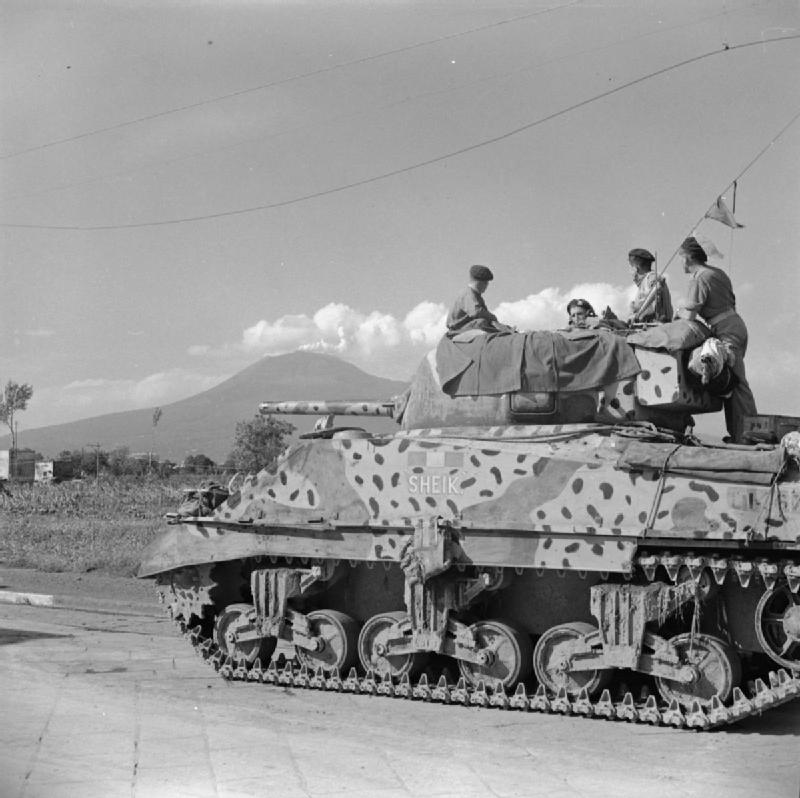
This shows the tank “Sheik” advancing towards Naples after the battle in late September (not far from Pompeii by the look of Vesuvius). It is in a very curious colour scheme, and this has drawn a lot of attention. Lots of modellers have been unable to resist representing it, and there is even a die-cast model of the tank on sale. It has a two colour camouflage base pattern, with pale and medium tone components. This is usually interpreted as Light Mud for the pale tone (one of the standard Mediterranean theatre British camouflage colours of the time – a greyish sand colour) and olive drab for the medium, the colour that the tank would have been painted when shipped over from the US under Lend-Lease. There is a darker tone used to give the dapple on the pale tone – probably the Blue Black that was also part of the standard British set. Other points to note are that there is are two aerial pennants, and the red-white-red British identification flash on the side.
The next picture is from the Osprey and Pan/Ballantine books: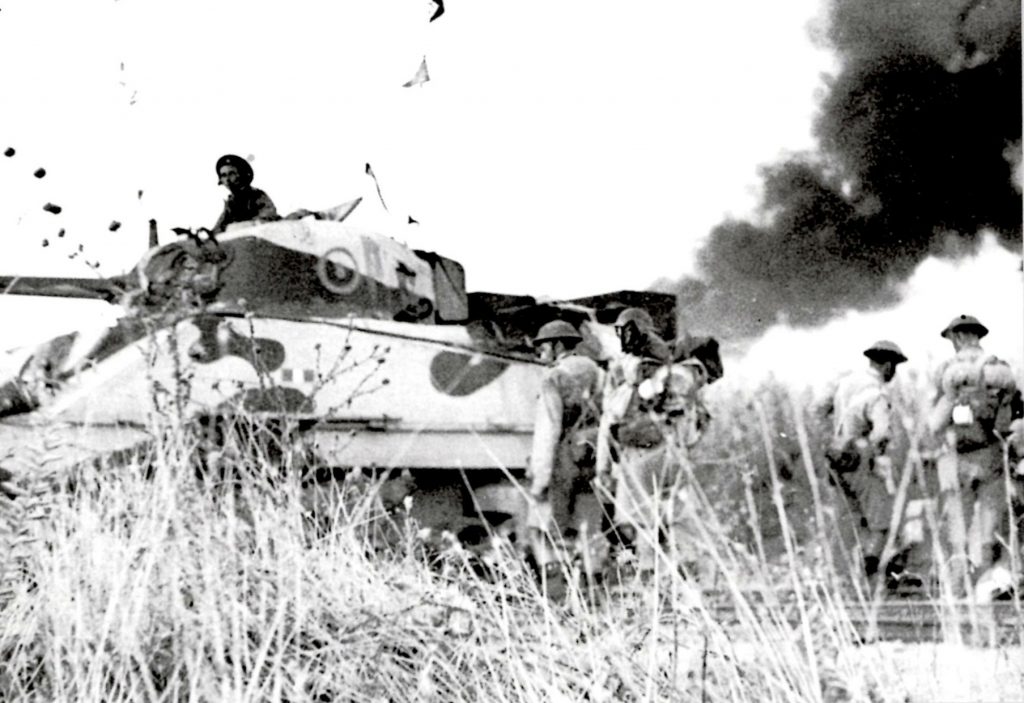 It shows a tank of the RSGs during the battle (near Battapaglia according to the Pan/Ballantine). Points of interest: there is a two-tone camouflage, but with light-dark tone, not light-medium. This is surely Light Mud and Blue Black, in accordance with standard British practice of the time. There is a tactical mark on the turret – a circle with the number 8. The Osprey says the circle denotes B Squadron; I think C squadron was more likely (B is usually a square). The number is the tank number. The red-white-red flash is visible and there are two or three pennants on the aerial.
It shows a tank of the RSGs during the battle (near Battapaglia according to the Pan/Ballantine). Points of interest: there is a two-tone camouflage, but with light-dark tone, not light-medium. This is surely Light Mud and Blue Black, in accordance with standard British practice of the time. There is a tactical mark on the turret – a circle with the number 8. The Osprey says the circle denotes B Squadron; I think C squadron was more likely (B is usually a square). The number is the tank number. The red-white-red flash is visible and there are two or three pennants on the aerial.
The next picture is from just the Osprey I have now found the original from the IWM collection, and substitute here:
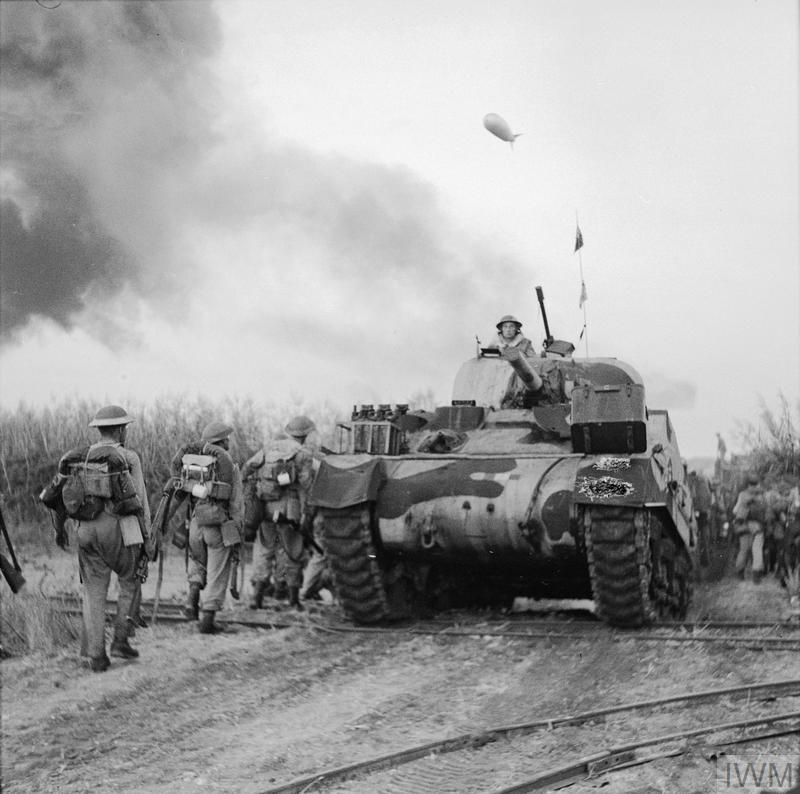
This looks as if it was taken at a very similar time. There are railway tracks in both pictures, and smoke. The barrage balloon indicates that it is quite near the beach. The scan above isn’t that clear – but the camouflage pattern looks the same, and the aerial pennants may be too. But it isn’t the same tank – this one has an AA machine gun on the turret. Of particular note on this picture is the unit ID signs on the left mudguard (i.e. left when facing forward – nautical “port”). The censor has scrubbed them out, but we can see that there are two, and they are both on the left – unlike the normal situation of the Arm of Service marker on one side and formation badge on the other. More on that later. There is a red-white-red flash in the front-centre. Incidentally this tank shows a single-piece nose for the Sherman – instead of the more usual three-piece one for this stage of the war – it is presumably quite a new tank.
The next picture is a poor one taken from the battle and only in the Pan/Ballantine: It is just about possible to see that the camouflage pattern is the same as the previous two pictures (and different from Shah). The regiment’s tanks were clearly painted in a standard pattern. Also note the single aerial pennant, and no AA machine gun. And the rear part of the track guard is still there.
It is just about possible to see that the camouflage pattern is the same as the previous two pictures (and different from Shah). The regiment’s tanks were clearly painted in a standard pattern. Also note the single aerial pennant, and no AA machine gun. And the rear part of the track guard is still there.
The next picture is from Wikipedia and shows one of RSG’s tanks in the follow up towards Naples, and near contemporary with the Shah picture:  Not much to add here except to note that the standard camouflage pattern turns up again. The rear of the track guard is missing -as with Shah and the other later picture, suggesting they were deliberately removed soon after the Salerno battle.
Not much to add here except to note that the standard camouflage pattern turns up again. The rear of the track guard is missing -as with Shah and the other later picture, suggesting they were deliberately removed soon after the Salerno battle.
The final picture comes from October as the unit was advancing with 23 Armoured brigade; it comes from the Imperial War Museum:

There are a few points of interest here. Once again it has the same camouflage pattern (a shame though that I have no pictures of the right hand side!), though the contrast is much lower than earlier (and similar to the Shah picture). Either that’s the effect of a couple of months weathering, or the Blue Black has been overpainted – or perhaps it just indicates lower ambient light conditions. Note that the stowage turret box doesn’t have the camouflage pattern on it, and in picture two it doesn’t look as if it has been repainted at all – this may have been a late addition. The red-white-red flash is just visible. The tactical mark is a square (as would normally be appropriate for B squadron), but I can’t see a number in it (incidentally don’t confuse it with the outlined panel behind it on the turret).
And now to a secondary source. A Star Decals sheet (these are a valuable resource):
The first two are of interest. the first is an interpretation of Shah. It shows it with a triangular tactical mark, appropriate to A Squadron (on the back of the stowage bin too), but with no number. It is shown in red, as would be used for a senior regiment in a brigade. It also shows an interpretation of the unit ID on the left mudguard – a thistle on on white over black square The text says that this sign was visible on tanks earlier in the campaign, but can’t be confirmed for this tank with its new camouflage scheme. It is clearly specific to the regiment – not the more usual brigade or division (the thistle standing for Scotland). The second picture is of a tank named Roosevelt – but not from any photograph I have seen. There is some doubt as to whether this is the RSG or 44 RTR (part of 4 Armoured brigade and not at Salerno). The name apparently doesn’t conform to the RSG naming system (Royal Navy ships) – but otherwise it looks very like the tank from picture 2 (though the number is 10). The portrayal of the camouflage pattern is different, but not by that much (mainly the turret) – perhaps just interpretation from an obstructed picture.
And so what are my conclusions? Shah looks like a one-off to me. Other regiments seem to have been using tanks without a camouflage pattern or with a low tonal contrast one (including the 40th RTR, according to the only picture I have). Perhaps the RSGs received one of these as a replacement and then improvised the camouflage scheme from there. I will use the Light Mud and Blue Black scheme, guessing the right side elements that I don’t have info on. The red-white-red flashes will also appear. Fortunately the Italeri kits I’m using have these in their decals. I will also do C squadron with red circle tactical marks and three consecutive numbers. I don’t have definite information on the numbering system, but a Flames of War graphic for New Zealand units suggests sequences starting with 3, 6, 9 and 12 for each of the main troops (and 15 for the HQ troop – 1 and 2 don’t appear to be used within the squadrons). I have four models, and I may do a further tank for the squadron leader, to act as a senior officer for larger games. Which tanks got the AA machine guns I don’t know – I speculate that it is the troop leader.
The next point is to have aerial pennants. These were subject to considerable variation – sometimes daily. I will give the troop leader two pennants and the others one. Perhaps they all get a red one, with yellow for the troop leader, as suggested by the Star Decals sheet. These will give the tanks a British look.
Another aspect of making the unit look British are the unit IDs. Here all I have to go on is the censor’s scratchings out on picture 2 and the Star Decals suggestion. The lower mark looks quite wide compared to its height. That would suggest a three digit number for an Arm of Service serial. That would be an Army level serial as often used for independent brigades (the numbers being 171-3 or 161-3 for armoured brigades). The formal organisational status of the RSGs at this point is a bit unclear – and this is emphasised by the use of a regimental formation sign rather than the more usual division or brigade. The formation sign is, presumably, the thistle badge, and located above the presumed unit serial. I am not sure what I am going to do here. I am tempted to leave these off (as I will the registration numbers and tank names) – but, then again, they do make the tank look British.
So most of the pieces of the jigsaw are in place. What is clear is that I will need to print my own decals on this, for the tactical signs and the unit ID, if I use them. A new challenge!
Update 27 August 2017
I continue to scratch the itch on this one. Some more Google searches have taken me to some new bits of data. First there is this online discussion from 2007 in which the RSG Shermans are discussed. Alas all the picture links are deceased, as it includes one or two pictures I haven’t got – including one which shows the unit thistle badge. There are a number of items of detail that I will ignore – I don’t need the model to be 100% accurate on the technical details. However it did draw me to this Pathé film. Amongst other things it includes the river crossing by the RSG tank in the last picture above. Here is a still from it. 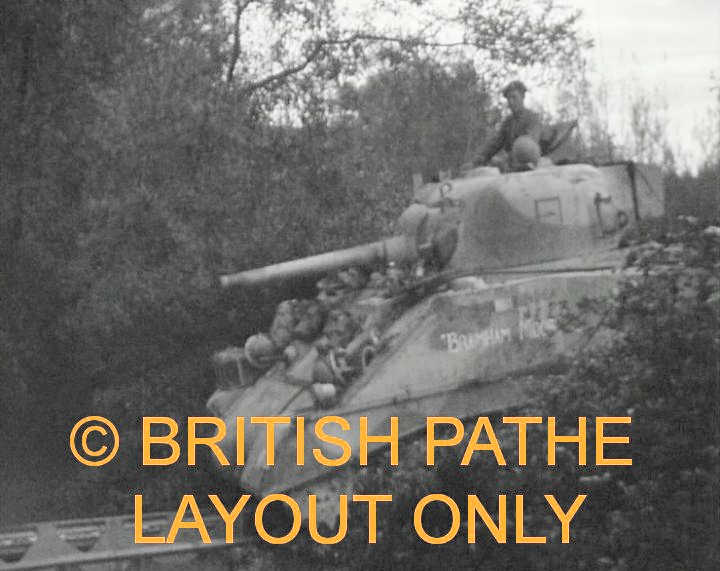 You can just about see the thistle badge on the front mudguard (take my word for it – though you do need the eye of faith). Also of interest is that the the front door of the commanders’ hatch has been removed – a common British practice apparently. The Italeri kit has the hatch moulded closed (the one point I don’t like about it). I was going to carve out the closed hatch anyway; I won’t have to make the front hatch door!
You can just about see the thistle badge on the front mudguard (take my word for it – though you do need the eye of faith). Also of interest is that the the front door of the commanders’ hatch has been removed – a common British practice apparently. The Italeri kit has the hatch moulded closed (the one point I don’t like about it). I was going to carve out the closed hatch anyway; I won’t have to make the front hatch door!
I have unearthed another couple of interesting pictures. This is from another unit at Salerno (the London Yeomanry, part of the 7th Armoured division): 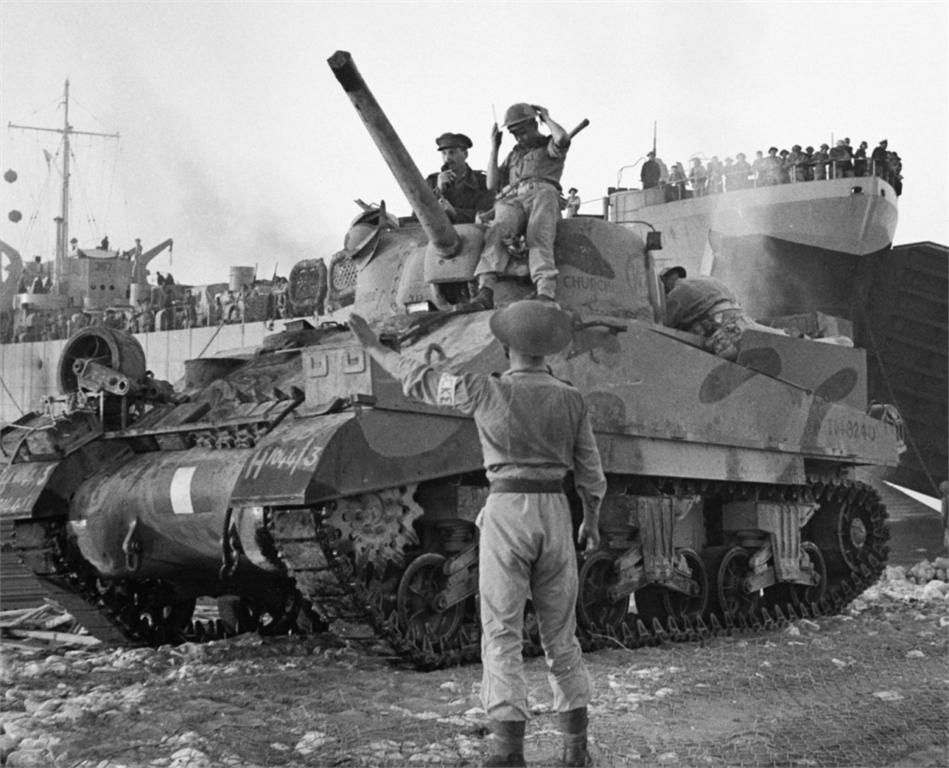 The camouflage scheme is similar but not the same. The dark colour may not be Blue Black though. The markings on the front mudguard are temporary identifiers – no doubt this is what those mysterious scratched out marks are on Picture 3 (apart from the thistle badge).
The camouflage scheme is similar but not the same. The dark colour may not be Blue Black though. The markings on the front mudguard are temporary identifiers – no doubt this is what those mysterious scratched out marks are on Picture 3 (apart from the thistle badge).
And then there is this picture of a tank from an unknown unit in Italy:  Of interest is the right side camouflage pattern, broadly consistent with the RSG. The RSG pattern appears to be based on a standard recommended pattern issued by the army, though some of the darker stripes are a bit broader, and there is no stripe on the back of the turret. This pattern gives me something to work on for the missing bit. I have not been able to find the original diagram that was used though, amid all the verbiage on camouflage patterns. All I know is that the patterns aren’t the same as those used earlier in the desert.
Of interest is the right side camouflage pattern, broadly consistent with the RSG. The RSG pattern appears to be based on a standard recommended pattern issued by the army, though some of the darker stripes are a bit broader, and there is no stripe on the back of the turret. This pattern gives me something to work on for the missing bit. I have not been able to find the original diagram that was used though, amid all the verbiage on camouflage patterns. All I know is that the patterns aren’t the same as those used earlier in the desert.
And after I had written that I searched all the Imperial War Museum’s collection on Salerno and found this one:
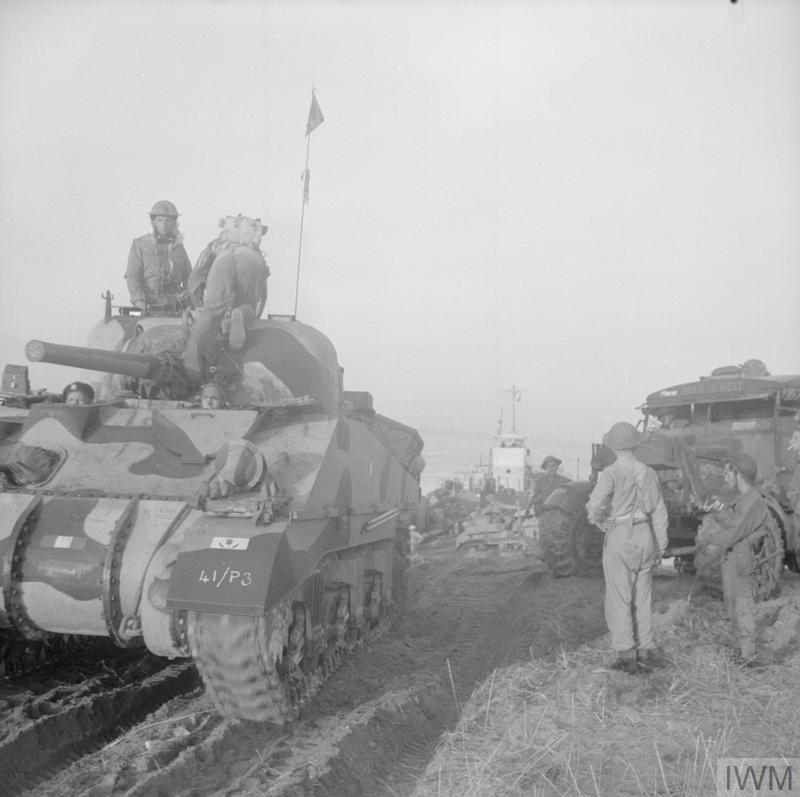
It’s the missing link. The thistle insignia is now clearly visible, above the temporary number. And there is also a clear picture of the front camouflage pattern – though I think there is a bit of variation with the other pictures. Two flags on the pennant. This tank has the three part nose, but is missing the rear track guard. Zooming in I can just make out a circular tactical mark, indicating C Squadron, but not the number in it.
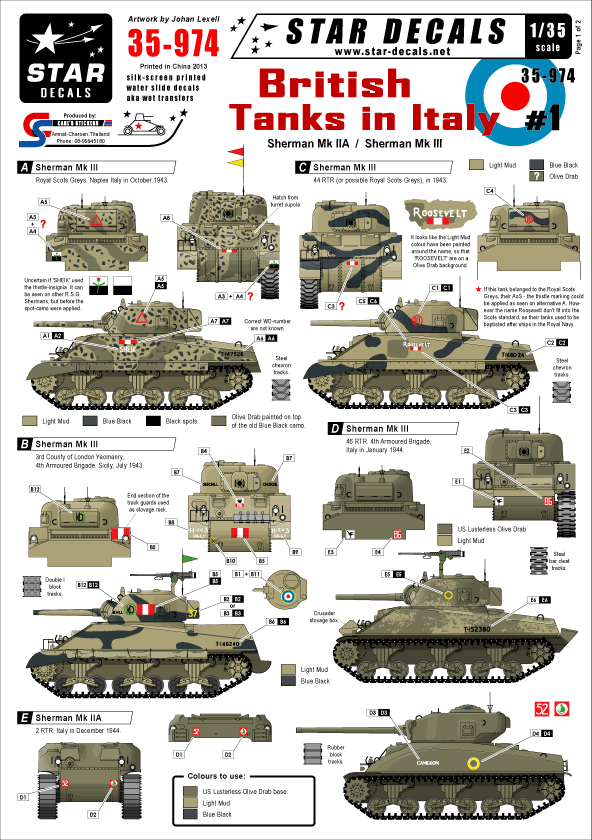
Thank you very much for this. I am trying to do RSG and Commandos forces for Salerno campaign and this is very helpfull. My question is, and if you have any idea how to identify tanks with three part front hull or with cast hull. Sheikh (via Star Decals) has three part hull but others have cast one. Are all of them Mk III?
The critical feature of the Mark III/M4A2 is its diesel engine. I have no reason to think that the RSGs weren’t 100% Mk IIIs, as one source said they were. Mk III’s had both 3 part and cast front (as well as early and late mantlets), as can be seem from the Italeri and Armourfast kits. Since writing that article I’ve bought Concord’s book by Dennis Oliver, which has lots of pictures of British Shermans in Italy, though only one more of the RSGs. Sheikh is A squadron, and the only picture I’ve seen from that squadron. For B squadron there is that picture of the tank crossing the river – it has a cast front. There are a 3 pictures of vehicles from C squadron where I can see the front; one is cast, two 3 part. In fact most units seem to have a mixture of the two. All seem to have the old mantlet in September 1943, though the new one was starting to appear about that time. Using the italeri kits, all mine will have three part noses.
Good luck with your project. I have been interested in Salerno since I read a book by Hugh Pond on the battle when I was a teenager – but it seems to be very neglected. I’ve thought about trying to do some commandos, as their performance was outstanding – though not sure what distinctive features they had for this campaign.
My Grandad was in the RSG, he was a Sherman Tank driver. I cant remember but he said his tank had 52 or 53 on it.
Do you have any pictures of either id be grateful to see?
You should be very proud of your grandad. I’m afraid I don’t have any more pictures – and I have researching the 1943 Italian campaign only. They then moved on to Normandy and NW Europe in 1944. It’s hard to tell what what that number referred to – it doesn’t correspond to the tactical numbers on the turrets in Italy – though the Salerno pictures also show a temporary number which could be in that range. There is a longer serial number also, and it could be part of that – but it’s very rare to get a clear enough picture to distinguish it! Sorry I can’t be of more help.
My father (Capt Gordon Edmiston MC) served with the RSG in Italy (as a Second Lieutenant at that time) and then later all the way from Normandy to Wismar. He wrote a diary detailing his experiences (no photos of his tanks sadly!). If you email me I would be happy to send you a copy.
This is a fantastic article and as a lifetime collector and woggler “what’s not to like!” you have mentioned a PAN /BALLANTINE publication!? I have the CONCORD book “BR SHERMAN TANKS ” Dennis Oliver 7062 which covers the Sherman’s mentioned and others :the normal middle pages colour profiles etc. also other mag articles on N.AFRICA BR SHERMAN’S and ARMOUR of the period. MILITARY MODELLING mag printed an article on the RSG specific to your subject matter ! I have just bought the CORGI :RSG M4A3 SHERMAN Italy 1943 “BULLET” serial no:T34657 no track guards no stowage on the die cast model. Thanks for the research /article!
This is a fantastic article! Thanks for posting up I have just last weekend bought the CORGI diecast M4A3 SHERMAN “BULLET” serial no: T 34657 NO track guards or stowage on model but with .50 cal HY MG fitted I have another and possibly 1 other of the same model somewhere? I also have some modelling magazine articles specific to your subject matter good luck regards the tank troop project ;of which WE can never have too many !! THANKS hope this spurs more interest ?!